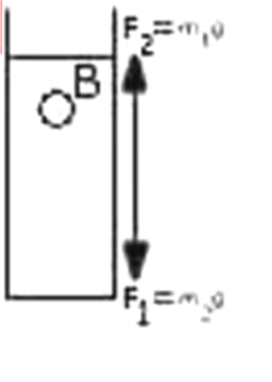 Short Answer Type
Short Answer TypeCopy and complete the following nuclear equations by filling in the correct values in the blanks:
 Long Answer Type
Long Answer TypeState Newton’s second law of motion both in words and in equation form. Under what condition does this equation become F = ma?
The radius of the driving wheel of a set of gears is 18 cm. It has 100 teeth and rotates at a speed of 30 rpm. The driven wheel rotates at a speed of 150 rpm. Calculate:
i) the gear ratio; ii) the number of teeth on the driven wheel and iii) the radius of the driven wheel.
A small stone of mass m = 200 g is held under water in a tall jar and is allowed to fall as shown in the figure. The free body diagram of the stone is also shown:
i) What do F2 and m1 represent?
ii) Calculate the net force acting on the stone and
iii) its acceleration as it falls through water. (Neglect the force due to viscosity. Take the volume of the stone as 80 cm3, density of water as 1.0 g/cm3 and acceleration due to gravity, g = 10 m/s2.
A thermos flask of negligible heat capacity contains 100 g of ice and 30 g of water.
i) Calculate:
1. the mass of steam of 1000 C needed to condense in the flask so as to just melt the ice.
2. the amount of water in the flask after condensation.
(Specific latent heat of vaporisation of the steam = 2260 J/g
Specific latent heat of fusion of ice = 336 J/ g
Specific heat capacity of water = 4.2 J.g0C)
ii) Is it possible to condense the water formed, back to ice by adding ice at 0o C? Explain giving a suitable reason to justify your answer.i) State the principle of calorimetry.
ii) Express 1 k/wh in terms of S.I. unit of energy.
iii) Which of the two, 1 g of ice at 0o C or 1 g of water at 0o C contains more heat? Give reason for your answer.An electric bulb rated 220 V, 60 W is working at full efficiency.
i) State the resistance of the coil of the bulb.
ii) Another identical bulb is connected in series with the first one and the system is connected across the mains as shown alongside:
Power, P = 60 W
Potential, V = 220 V
i ) Resistance, R =
1. When they are connected in series then total resistance of the two is,
RS = R1 + R2 = 806.7 + 806.7 = 1613.4 ohm
Therefore,

Power of each bulb, P = I2R = (0.136)2x 806.7 = 14.92 W
2. Total power, PS = 
3. When the bulbs are connected in parallel,
Total power, PP = P1 + P2 = 60 + 60 = 120 W
